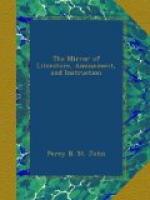Thus the groaning tree continued an object of astonishment, during the space of eighteen or twenty months, to all the country around; and for the information of distant parts, a pamphlet was drawn up, containing a particular account of it. A gentleman of the name of Forbes, making too rash an experiment to discover the cause, bored a hole in its trunk. After this it never groaned. It was then rooted up, with a further view to make a discovery; but still nothing appeared which led to any investigation of the cause. It was universally, however, believed, that there was no trick in the affair; but that some natural cause really existed, though never understood.—(Vol. I. p. 163.) P.T.W.
* * * * *
CURIOUS PARTICULARS RELATING TO HURLEY, IN BERKSHIRE.
(For the Mirror.)
Mr. Ireland, in his “Picturesque views on the river Thames,” observes that “the fascinating scenery of this neighbourhood has peculiarly attracted the notice of the clergy of former periods.”
Hurley Place was originally a monastery. In the Domesday Book, it is said to have lately belonged to Edgar; but was then the property of Geoffrey de Mandeville, who received it from William the Conqueror, as a reward for his gallant conduct in the battle of Hastings; and in the year 1086 founded a monastery here for Benedictines, and annexed it as a cell to Westminster Abbey, where the original charter is still preserved.
On the dissolution of the monasteries, Hurley became the property of a family named Chamberlain, of whom it was purchased, in the reign of Queen Elizabeth, by Richard Lovelace, a soldier of fortune, who went on an expedition against the Spaniards with Sir Francis Drake, and erected the present mansion on the ruins of the ancient building, with the property he acquired in that enterprise. The remains of the monastery may be traced in the numerous apartments which occupy the west end of the house; and in a vault beneath the hall some bodies in monkish habits have been found buried. Part of the chapel, or refectory, also, may be seen in the stables, the windows of which are of chalk; and though made in the Conqueror’s time, appear as fresh as if they were of modern workmanship. The Hall is extremely spacious, occupying nearly half the extent of the house. The grand saloon is decorated in a singular style, the panels being painted with upright landscapes, the leafings of which are executed with a kind of silver lacker. The views seem to be Italian, and are reputed to have been the work of Salvator Rosa, purposely executed to embellish this apartment. The receipt of the painter is said to be in the possession of Mr. Wilcox, the late resident.




